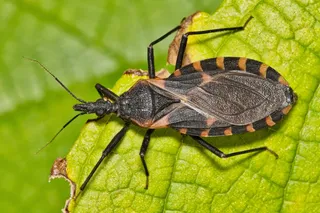Innate social aptitudes of man is a controversial paper. As noted in the biographical introduction to it William D. Hamilton states that his friend Robert Trivers referred to it as the "fascist paper" (see Natural Selection and Social Theory for Trivers' perspective on his relationship with Hamilton). Not because Trivers himself thought it was fascist, rather, that was simply the perception of most who read and criticized the paper. The most vociferous critic was the biological anthropologist Sherwood L. Washburn (see Defenders of the Truth for a detailed exposition of Washburn's many critiques of Hamilton's genetic take on ethology). Hamilton found Wasbhurn's hostility bewildering in part because he had introduced Innate social aptitudes of man with a quotation from Washburn's own work. Additionally, he quite admired Washburn's research program in anthropology; the attempt to synthesize both the humane and biological elements of the discipline. Hamilton suggests that perhaps some of the attack was motivated by the tendency of controversial pioneers to "prove" their own basic decency to skeptical peers by anathematizing those who push the envelope even further. But in all honesty I don't think that was the story or the totality of the issue; though Hamilton's paper was not a normative prescription of how humans should be, his Malthusian sensibilities suffuse the speculative comments which make up the bulk of the second half of the paper, and those sensibilities can be shocking in polite company. And if there is something that can be said for modern day anthropologists, they tend to be quite "polite" and correct in both substance & style. Yet whatever issue one might have with the second part of Hamilton's narrative, the first half is a quite elegant exposition of the application of the Price equation to biological questions. In his personal notes Hamilton freely admits that George Price's formalism was both simpler & more general than his earlier more labored derivations of the principle of kin selection. The Price equation is transparent and works with well known formal currency. In Innate social aptitudes of man Hamilton brings his interest in questions demographic and genetic to our own species, and uses the ability of the Price equation to decompose levels of selective effect for the purposes of analysis. Since we're going to be talking about genetics here I'm going to use genetic analogies and terminology instead of describing the parameters within the Price equation in more general terms. Do note that the formalism is easily applicable to questions about culture or society which involve no genetic dimension (see Cultural & Evolutionary Process). To make it simple Hamilton assumes that a population is haploid & asexual, that is, only one copy of a gene. That simplifies the math though the general insights shouldn't be that different. First, a subpopulation is defined by the subscript, s
ns
, number of gene copies (which is equivalent to the number of individuals since this is a single locus treatment)
qs
, frequency of allele, q, on the locus above within the subpopulation s. That is,
qs
is a subset of
ns
ws
, mean fitness within a subpopulation Next, the whole population, which is the sum of all the individuals/and or/gene copies N = Σ
ns
, where s refers to a subpopulation. Basically you're summing up the total number of gene copies here across all populations q = Σ
ns
qs
/N. This is just the total allele frequency across all populations w = Σ
ns
ws
/N. This is just the total fitness across all populations (remember that if a population is increasing w will be greater then 1) This is a discrete model with non-overlapping generations. We're interesting in evolution across the generations, so we'll use the prime superscript, ', to modify our parameters to indicate that they are 1 generation into the future. So the change in allele frequency in one generation within a subpopulation is: Δ
qs
=
q's
-
qs
And a whole population is: Δq = q' - q From which the Price equation drops out like so: w Δq = Σ
ns
ws
(
qs
- q )/N + Σ
ns
ws
Δq/N = Covariance (
ws
,
qs
) + Expectation (
ws
, Δ
qs
) You should have some idea of what covariance and expectation are from probability & statistics. Since they're pretty tried & true the later manipulations are understandable in that light. The covariance in this context represents the between group selection, that is, between the s's, while the expectation is the within group selection, the individual selection. The two terms are simply decomposing the two levels of selection, and the power of each level can be ascertained by examining these two parameters. Hamilton also notes that you can move up and down levels as well, for example shifting down one unit the covariance term would be individual selection and the expectation would be within genome dynamics, such as meoitic drive. In any case, the equation above can be rewritten as: w Δq = β1 Variance (
qs
) + Expectation (
ws
, Δ
qs
) Where β1 is the regression coefficient of
ws
on
qs
. In the human biological context Hamilton is interested in 'altruism,' especially the idea of alleles which might exhibit negative values in the second term (reduction in frequency within populations) and positive values in the first term (increase in frequency across populations). What could I mean by this? Imagine an allele, 1, on a locus, A. Let's assume that allele 1 results in the wild type ancestral behavior, basically a selfish morph which is low on group comity. The normal state of affairs of the species in question is to have loose demes of low cohesion, not necessarily a war of all-against-all, but in that direction. Now imagine that within this situation a new deme is "dropped in," (imagine you're on an island and a new group shows up). These are individuals of the same species, but they are fixed for a different allele on locus A, allele 2. This derived variant confers a hyper-altruistic tendency within the group, but great suspicion toward outsiders. The within group altruism means that the new deme operates almost as a super-organism. Unleashed upon the native populations they wreak havoc and marginalize them. There is no within group selection in the new deme where allele 2 is fixed because there is no variation on locus A. Because of suspicion toward outsiders there is no infiltration of altruistic deme for generations. Over time the total frequency of allele 1 drops as demes which are fixed for it go extinct in the face of the expansion of the deme fixed for 2. But...imagine that at a certain point an individual from the outside manages to get into the altruistic deme, an individual who carries allele 1. Now the situation changes. In a pairwise interaction between an individual carrying 1 and another carrying 2 (assume haploid for simplicity), the former receives fitness from the latter but does not return it. Because of the nature of within group dynamics the fitness of allele 1 within the deme dominated by allele 2 is higher than that of allele 2! That means that now the frequency of allele 2 will begin to decrease within the deme which it dominates. As long as allele 1 is at low frequency the deme can still expand and grow; the frequency of allele 2 still increases overall within the population because allele 1 bearing demes are still going extinct. But, in the long run allele 1 will again become fixed in the population because it wins in a pairwise match up when population substructure is not maintained. The above model, though grossly simplified, shows why systems which purport to maintain and illustrate higher than individual level selection need to manifest population substructure and migration. In the long run without some viscosity in spatial distribution and processes to check it individual selection always wins (on the other hand, in the long run we're all dead. Sometimes the interval between contingent birth and inevitable death is really where the action is). Most of these models seem artificial, but the point is to illustrate the general possibility, not to mimic reality as such. Hamilton points to a relatively unrealistic model posited by J. B. S. Haldane, and uses it as a stepping stone toward a more plausible scenario which can maintain altruistic tendencies through higher level dynamics. Imagine that individuals which are altruistic give up k units of fitness to add K units to the joint fitness of others in their group (of which, there will be n - 1). Expand the Price equation recursively: w Δq = β1 Variance (
qs
) + β0 Expectation { Variances (
qsi
) } The second term is now within group variance, the i subscript denotes individuals which generate the variance within the subpopulation. β0 is the regression coefficient of
wsi
on
qsi
Haldane's model posited that organisms would scatter at maturity from their natal groups and reform with others randomly. Because of random groupings the composition of subpopulations will be binomial with parameters ( q, n ), so the variance of
qs
is ( 1/n ) p/q, while expectation is { ( 1 - 1 )/n } p/q, so that: w Δq = ( 1/n ) pq { β1 + ( n - 1 ) β0 } Remember that β0 is associated with the within group variation. In large populations it will scale up appropriately; that is why the between group variation condition has to be set high. One of the reasons people are often skeptical of group selection in a genetic context is that between group variation, due to gene flow, is often very low. If selection scales proportional to the variation usually within group selection will quickly overpower between group selection simply as a function of differences in genetic variance. From the formalism above it naturally occurs that you have to know the proportions of altruists within each deme to infer the distribution of fitnesses. After a little algebra (not much), Hamilton derives this: w Δq = -kpq As one can tell by the negative sign the altruistic q allele is doomed in the long run. We knew that through verbal analysis, but the math makes it clear as well. How can we change this? Remember that the model stipulated that individuals assorted randomly when forming new groups. What if they engaged in some discrimination so that q associated with q greater than expectation? Let's add a new parameter, F, which is the correlation between of the genetic state of two random members of a given group. This a proxy for the tendency toward like with like association. The between and within group variances become: (1/n ) pq ( 1 - F + nF ) and (1/n ) pq ( n - 1 ) ( 1 - F ) As F → 1 note that within group variance disappears; obviously if everyone is of the same state there isn't any variation. In contrast, between group variance increases as one approaches 1. Imagine a case where the proportion of p & q are both 0.5, and there are two subpopulations of equal size which are fixed for p & q respectively. That's a case where F = 1, within group variance is 0 and between group variation is high (it is 0.25 since the n's cancel out). A last algebraic manipulation leaves us with: K/k > 1/F Which tells us the criterion for the positive selection of altruism. Remember that K is the total fitness increase to the group which an altruist contributes, k is its own decrement of fitness. If group benefits are modest, then the correlation must be strong, or, if the correlation modest, the group benefits must be powerful. Remember that this is a model predicated on groups forming and dispersing; these models are contingent upon ongoing dynamics. If you're interested in group selection models, check out this post, or, Unto Others: The Evolution and Psychology of Unselfish Behavior (the title says it all). I actually presented most of the "math" in this article. The Price equation is great in part because it so potentially simple; large return on cognitive investment. Its generality means that we can leverage our understanding of the nature of covariance, expectation and variance, to reformulate old problems. Hamilton ends the mathematical portion by declaring that the Price equation is the fullest expression of inclusive fitness, which can subsume kin selection, reciprocal altruism and group selection. So what's so controversial? After the mathematical treatment Hamilton remains on relatively innocuous ground initially; he enters into speculations on the extent of between deme migration, and the implications for particular patterns of partitioning of variance on behavioral tendencies. For example, he wonders if shoreline hominids were equaniminous in their relations because of the fact that stepwise migration models along a linear axis tend to reduce the deme to deme variance. Close relatives make good neighbors? Let me quote Hamilton:
...Other usually less drastic beliefs and practices affecting fertility that are widespread in human cultures may help to explain how they manage to be as peaceful as they are. In so far as the practices amount to effective birth control, they cut warfare at its demographic root. Unfortunately, it is possible that in doing so they also cut an important linke that has escalated the selection for intelligence. No hunt needs quite so much forethought or ability to communicate complex instructions as does a war, nor do such drastic demographic consequences hinge on the outcome.
In short, Hamilton is saying that war makes us smart, it culls the stupid. This passage is not atypical, and it's a rather standard extrapolation from the Malthusianism which permeates Hamilton's writing. In the biographical introduction to this chapter he does not repent of any of his assertions; he argues that as a biologist he is interested in the biological roots of human behavior, he can do no other. Unfortunately, suppositions such as the fact that war requires more intelligence than hunting seem a bit tendentious. Hamilton admits that he did little extraneous reading so part of the problem is that the first half of the paper exhibits a tight focus, but the latter half occasionally veers into the sorts of conversations that evolutionary biologists might engage in at dinner parties. All sorts of off-the-shelf ideas gleaned from Horizon documentaries were synthesized within the framework of the Price equation; some of it was interesting, some of it seemed wild, and much of it was no doubt the sort of talk which would raise the hackles of any anthropologist. Hamilton notes that Sherwood Washburn was especially offended by his discussion of the tendencies toward altruism which pastoralists might manifest to a greater degree than agriculturalists, and that the efflorescences of creativity after the conquests of the nomads in many civilizations may reflect the injection of these altruistic genes. Certainly rank speculation; but absolutely intelligible in light of the earlier material which emphasizes that altruism requires these large scale dynamics of populations mixing, segregating and dispersing, to persist. Between group selection does need some sort of discriminatory element; if Hamilton had left the paper at the abstract and ultimate level he would have received little objection, rather, his exploration of the proximate aspects crossed a cultural line. But evolution is in large part about intraspecific conflict; if that conflict is diminished across individuals, in a Malthusian world it nevertheless must manifest between groups. If humans are animals the same sort of savage behavior operant among other organisms are certainly likely in part the products of evolution within our own species. We show no reluctance to engage in, or perfect, barbarism and cruelty. We may strive for universal morality, but most would admit that that is an ideal. Hamilton's basic sympathy with Thomas Malthus' arguments on occasion gets the better of him, and this tendency makes it seem that the descriptions he is reporting are actually prescriptions he is recommending to the overly sensitive reader. Read a la carteInnate social aptitudes of man may shock, but within the context of the biographical introductions scattered across his two initial volumes of collected papers it is simply a specific exposition on a long line of thinking.













